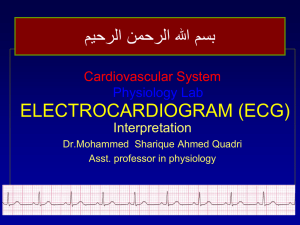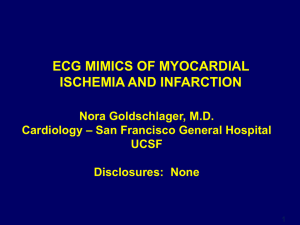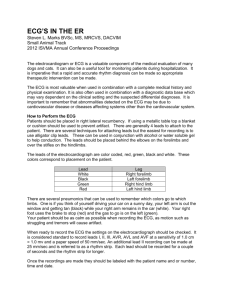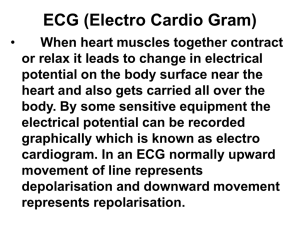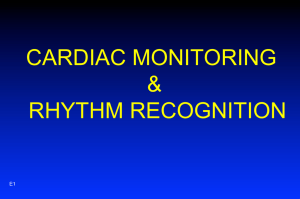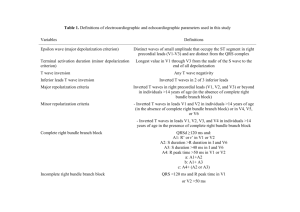Start with the rhythm strip (II)
advertisement
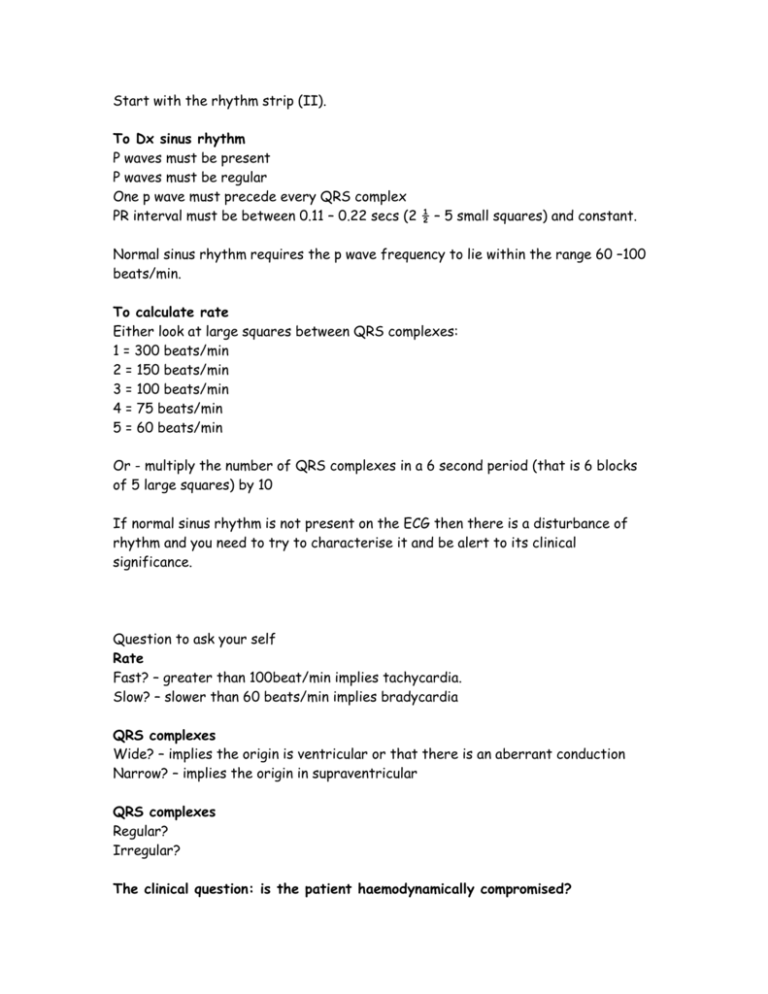
Start with the rhythm strip (II). To Dx sinus rhythm P waves must be present P waves must be regular One p wave must precede every QRS complex PR interval must be between 0.11 – 0.22 secs (2 ½ – 5 small squares) and constant. Normal sinus rhythm requires the p wave frequency to lie within the range 60 –100 beats/min. To calculate rate Either look at large squares between QRS complexes: 1 = 300 beats/min 2 = 150 beats/min 3 = 100 beats/min 4 = 75 beats/min 5 = 60 beats/min Or - multiply the number of QRS complexes in a 6 second period (that is 6 blocks of 5 large squares) by 10 If normal sinus rhythm is not present on the ECG then there is a disturbance of rhythm and you need to try to characterise it and be alert to its clinical significance. Question to ask your self Rate Fast? – greater than 100beat/min implies tachycardia. Slow? – slower than 60 beats/min implies bradycardia QRS complexes Wide? – implies the origin is ventricular or that there is an aberrant conduction Narrow? – implies the origin in supraventricular QRS complexes Regular? Irregular? The clinical question: is the patient haemodynamically compromised? Level of consciousness BP Tachypnoea Chest pain/SOB Sequentially answering these simple questions allows you to immediately narrow down the and to initiate either fast, emergency action or less urgent, more considered action. Dx: How fast is the rhythm? Fast Normal Slow The ECG is a good investigation to feel confident about interpreting. This is because: It provides very good information about the structure and function of a lifemaintaining organ.. It is cheap, easily performed and harmless. ECGs provide information about: The rhythm – the sequence of depolarisation of the myocardium manifested by the timing and frequency of the p waves and the QRS complexes and their interrelationships. Morphological information – information concerning the physical condition of the heart. This information is contained within the morphology of the p wave, QRS complexes, ST segments and the T wave. Like the, the ECG contains a lot of information. This means that unless a methodical approach is taken to interpretation, information is easily missed. Physiologic Properties of Cardiac Muscle Excitability is the ability of the myocardial cell to respond to a stimulus Automaticity allows a cell to reach a threshold potential and generate an impulse without being stimulated by another source Conductivity refers to the ability of the muscle to move an impulse from cell to cell Contractility allows the muscle to shorten when stimulated Normal Conduction Pathway Once an impulse originates in the sinus node, it travels from the sinus node through the atria to the AV node or junction, which also includes the bundle of His. The impulse is delayed in time at the AV node to allow the ventricles to fill with blood. From the AV node, the impulse travels very quickly through the bundle branches, terminating in the Purkinje fibers of the ventricular walls to initiate systole. The cycle then begins again. It is important to remember that an electrical stimulus is followed by a mechanical event of the heart. Autonomic Nervous System The heart is under the control of the autonomic nervous system, which consists of sympathetic (or adrenergic) and parasympathetic fibers. Stimulation of the sympathetic system accelerates heart rate, raises blood pressure, and enhances the force of myocardial contraction. Parasympathetic stimulation slows the heart rate, lowers blood pressure, and reduces the force of contraction. THE ELECTROCARDIOGRAM (ECG) graphic display of the conduction, magnitude, and duration of electrical activity generated by heart ECG machine (or monitor) transcribes onto graph paper, electrical activity generated by cells of the heart as ions are exchanged across cell membranes this electrical activity produces a current that radiates from heart throughout surrounding tissue to skin electrodes on skin sense these electrical currents and transmit them to ECG machine or monitor - machine or monitor transforms the electrical activity into a series of waveforms that correspond to heart's depolarization and repolarization upward (positive deflection) and downward (negative deflection) waveforms occur as a result of the directional flow of the electrical impulse straight (isoelectric) line occurs when there is no electrical activity or when the activity is too small to be measured standard 12-lead ECG consists of the recordings of 12 leads (I, II, III, AVR, AVL, AVF, VI, V2, V3, V4, V5, and V6), with each lead recording the heart's electrical activity from a different anatomical position rhythm strip is the ECG recording of one of these leads ECG Paper ECG machine records electrical activity onto standardized graph paper, usually running at a speed of 25 millimeters (mm) per second graph paper consists of small blocks (indicated by lighter lines) and large blocks (indicated by darker lines) horizontal axis represents time (in seconds), while vertical axis represents voltage or amplitude (in mm or millivolts [mV]) each small block on horizontal axis represents 0.04 second five small blocks form a large block, which represents 0.20 second duration of a waveform component is determined by counting number of small blocks from the beginning to the end of the waveform component and then multiplying that number by 0.04 second each small block on the vertical axis represents 1 mm (or 0.1 mV) each large block represents 5 mm (or 0.5 mV) voltage or amplitude of a waveform component is determined by counting number of small blocks from base (isoelectric) line to highest or lowest point of the waveform component top margin of paper usually marked by small vertical lines at either 1-sec (five large blocks) or 3-sec (15 large blocks) intervals Components of the ECG waveform include the P wave, the PR interval, the QRS complex, the ST segment, the T wave, and the QT interval. Occasionally a U wave may be seen. The P Wave Represents atrial depolarization. Normal duration is 0.04 to 0.11 second. Usually upright and rounded; normal amplitude is 3 mm or less. Presence indicates the impulse originated in either the SA node, atrial or AV junctional tissue. Normally sized, shaped, and positioned P waves indicate the impulse originated in the SA node; absent or abnormally positioned P waves indicate the impulse originated outside the SA node. The PR Interval Represents the time it takes an impulse to travel from the atria through the AY node, bundle of His, and bundle branches to the Purkinje fibers. Measured from the beginning of the P wave to the beginning of the QRS complex. Normal duration is 0.12 to 0.20 second. Length signals the presence of an impulse formation or conduction delay disturbance. Prolonged PR interval associated with first-degree AY block and with digitalis toxicity; shortened PR interval associated with junctional rhythms and preexcitation syndromes. The QRS Complex Represents ventricular depolarization. Consists of the Q wave (the first negative deflection or the negative deflection before the R wave), the R wave (the first positive deflection), and the S wave (the second negative deflection or the negative deflection after the R wave). Measured from the beginning of the QRS complex to the end of the QRS complex. Normal duration is 0.06 to 0.12 second. Configuration will look different in each lead. Widened QRS complex may occur with conditions in which the impulse formation occurs in the ventricles, such as premature ventricular contractions, and with conditions that slow conduction of the impulse to one of the ventricles, such as bundle branch blocks. The ST Segment .Represents the time between the end of ventricular depolarization and the beginning of ventricular repolarization. Measured from the end of the QRS complex to the beginning of the T wave. Normally isoelectric. May be elevated in acute myocardial injury; depressed in myocardial ischemia or injury; shortened with hypercalcemia; lengthened with hypocalcemia. The T Wave Represents ventricualr repolarization. The peak of the T wave represents the time during which the ventricles are especially vulnerable to stimuli (the vulnerable period). Normally upright and rounded (usually follows the same deflection pattern as the QRS complex). Inverted T waves may indicate myocardial ischemia. Tall, peaked (tented) T waves usually indicate hyperkalemia. The QT Interval Represents the time required for ventricular depolarization and ventricular repolarization to occur. Measured from the beginning of the QRS complex to the end of the T wave. Duration varies according to age, sex, and heart rate (commonly 0.36 to 0.44) but should not be greater than one half the length of the R-R interval if the rhythm is regular. Prolonged with Type I antiarrhythmic medications, sinus bradycardia, or with an congential or familial origin; shortened with hypercalcemia, digitalis, or sinus tachycardia. INTERPRETING AN ECG To interpret an ECG rhythm strip, analyze it using a consistent, systematic approach. Presented below is one method. 1. Scan the ECG strip. Look at the entire strip and identify the ECG waveform components. 2. Determine the atrial and ventricular rates. To determine the atrial and ventricular rates, calculate it using one of the following methods: Times Ten Method. Count the number of P waves within a 6-second strip. Multiply that number by 10. This is the estimated atrial rate. Then count the number of R waves within the 6-second strip. Multiply that number by 10. This is the estimated ventricular rate. Sequence Method. Find a P wave that peaks on the dark block line. Count off the next six dark lines as 300, 150, 75, 60, and 50 respectively. Find the dark line on which the next P wave peak rests. The number assigned to that dark line is the estimated atrial rate. To determine the estimated ventricular rate, use the R wave instead of the P wave and repeat the above procedure. 1500 Method. Find two consecutive P waves. Count the number of small blocks between identical points on each wave. Divide 1500 by the number of small blocks (There are 1500 small blocks in one minute.) This is the atrial rate. To determine the ventricular rate, find two consecutive R waves and repeat the procedure. Then ask these questions: Is the rate fast, slow, or normal (60 to 100 beats per minute)? Are the atrial and ventricular rates the same? If not, is there a pattern to the difference? 3. Determine the atrial and ventricular rhythms. To determine the atrial and ventricular rhythms, use one of the following methods: Paper and Pencil Method. Place the straight edge of apiece of paper along the ECG strip. With a pencil, make a dot on the paper at each of two consecutive P waves. This is the P-P interval. Now move the paper across the strip, lining up the two dots with each consecutive P wave. If the distance between all of the P waves is the same, the atrial rhythm is regular; if the distance varies, the rhythm is irregular. Then using the same method, measure the distance between the R waves of consecutive QRS complexes. This is the R-R interval. If the distance between all of the R waves is the same, the ventricular rhythm is regular; if the distance varies, the rhythm is irregular. Calipers Method. Place the ECG strip on a flat surface. Put one pointed end of the ECG calipers on the peak of a P wave. Adjust the legs so that the other point is on the peak of the next P wave. This is the P-P interval. Move the calipers so that the first point of the calipers is on the peak of the second P wave and so on. If the distance is the same, the atrial rhythm is regular; if the distance varies, the atrial rhythm is irregular. To determine the ventricular rhythm, repeat this procedure using the R wave and measuring the R-R intervals of consecutive QRS complexes. If the distance is the same, the ventricular rhythm is regular; if the distance varies, the ventricular rhythm is irregular. 4. Evaluate the P waves. To evaluate the P waves, look at the size, shape, and where they appear on the ECG. Then ask these questions: Are P waves present? Do the P waves have a normal shape and size? Do all the P waves have the same configuration? Is there one P wave present for each QRS complex? 5. Measure the PR interval. To measure the PR interval, count the number of small blocks between the beginning of the P wave and the beginning of the QRS complex. Multiply that number by 0.04 second. The normal interval is between 0.12 and 0.20 second or between 3 and five small blocks wide. Then ask these questions: Does the duration of the PR interval fall within normal limits? Does the duration of the PR interval vary from one ECG complex to another ECG complex? 6. Measure the QRS complex. To measure the QRS complex, count the number of small blocks between the beginning of the QRS complex and the end of the QRS complex. Multiply that number by 0.04 second. The normal width is 0.06 to 0.10 second or one and one half to two and one half blocks wide. Then ask these questions: Does the width of the QRS complex fall within normal limits? Do all of the QRS complexes have the same configuration? Is there a QRS complex for each P wave? Do any of the QRS complexes come earlier or later than expected? 7. Evaluate the T wave. To evaluate the T wave, look at the deflection and height of the T wave. Then ask these questions: Is the T wave positively or negatively deflected? Does the deflection of the T wave follow the deflection of the QRS complex? How high is the T wave? Is it peaked? 8. Measure the QT interval. To measure the QT interval, count the number of small blocks from the beginning of the QRS complex to the end of the T wave. Multiply that number by 0.04 second. Then ask this question: Does the QT interval fall within normal limits? 1. 9. Interpret the ECG. To interpret the ECG, compare the measurements and findings to the ECG characteristics of the various dysrhythmias. Find the one that most closely matches. This is the interpretation. Use this information to help assess and evaluate the patient's condition. However, keep in mind to always correlate the ECG findings with the patient's clinical condition. An ECG tracing is a graphic recording of the heart’s electrical activity. The paper consists of horizontal and vertical lines, each 1mm apart. The horizontal lines denote time measurements. When the paper is run at a sweep of 25mm/second, each small square is equal to 0.04 seconds, whereas a large square [five small squares] equals 0.02 seconds. Height or voltage is measured by counting the lines vertically. Most ECG paper is also marked at 3 second intervals along the top or bottom for rate calculation. Calculation of Heart Rate Although monitors provide a continuous display of the heart rate, it is usually necessary also to determine atrial and ventricular rates on the rhythm strip. To calculate the heart rate, the following methods can be used; ¨ Identify a 6 second strip of ECG paper. Count the number of complexes within the 6 seconds and multiply by ten. ¨ Calculate the number of large squares between two QRS complexes and divide into 300. These methods can be used for regular as well as irregular rhythms and is accurate within +/- 5 beats per minute. Waveforms and Intervals During the cardiac cycle, the following waveforms and intervals are produced on the ECG tracing. P Wave : A small deflection representing depolarisation of the atria. It is normally seen before the QRS complex at a consistent interval. PR interval : The interval representing conduction time through the atria, AV node, bundle of His, and bundle branches, up to the point of activation of the ventricular muscle tissue. The interval is measured from the beginning of the P wave, to the beginning of the QRS complex. A normal PR interval is 0.12 - 0.20 seconds. QRS Complex : A large waveform representing ventricular depolarisation. Each component of the waveform has a specific connotation. The initial negative deflection is a Q wave, the initial positive deflection is an R wave and the negative deflection after the R wave is an S wave. Not all QRS complexes have all three components, even though the complex is commonly referred to as the QRS complex. ST Segment : The segment between the end of the QRS complex and the beginning of the T wave. Normally it is isoelectric at baseline, but may be elevated or depressed in a variety of conditions. T Wave : A deflection that represents ventricular repolarisation or recovery. It appears after the QRS complex. QT Interval : The interval representing total duration of ventricular electrical systole. The QT interval is measured from the beginning of the QRS complex to the end of the T wave. A normal QT does not usually exceed 0.42 seconds. Steps in assessing a Rhythm Strip 1. Identify the QRS complexes. 2. Look for the P waves. If present, are they all the same configuration ? Is there a P wave for every QRS complex ? 3. Measure the PR interval. Is it normal ? Is it the same throughout the strip, or does it vary ? 4. Evaluate the QRS complex. Is it normal in width, or is it wide ? Are all the complexes of the same configuration ? Is there a QRS complex for every P wave? 5. Determine the atrial and ventricular rates. Are they within normal limits ? Is the atrial rate the same as the ventricular rate ? If not, is there any relationship between the two ? [i.e. is one a multiple of the other] 6. Identify the rhythm and determine it’s clinical significance. Is the patient symptomatic ? [Check skin, neurological status, Coronary circulation and haemodynamic status / blood pressure] Is the arrhythmia acute or chronic ? Is the arrhythmia life threatening ?

